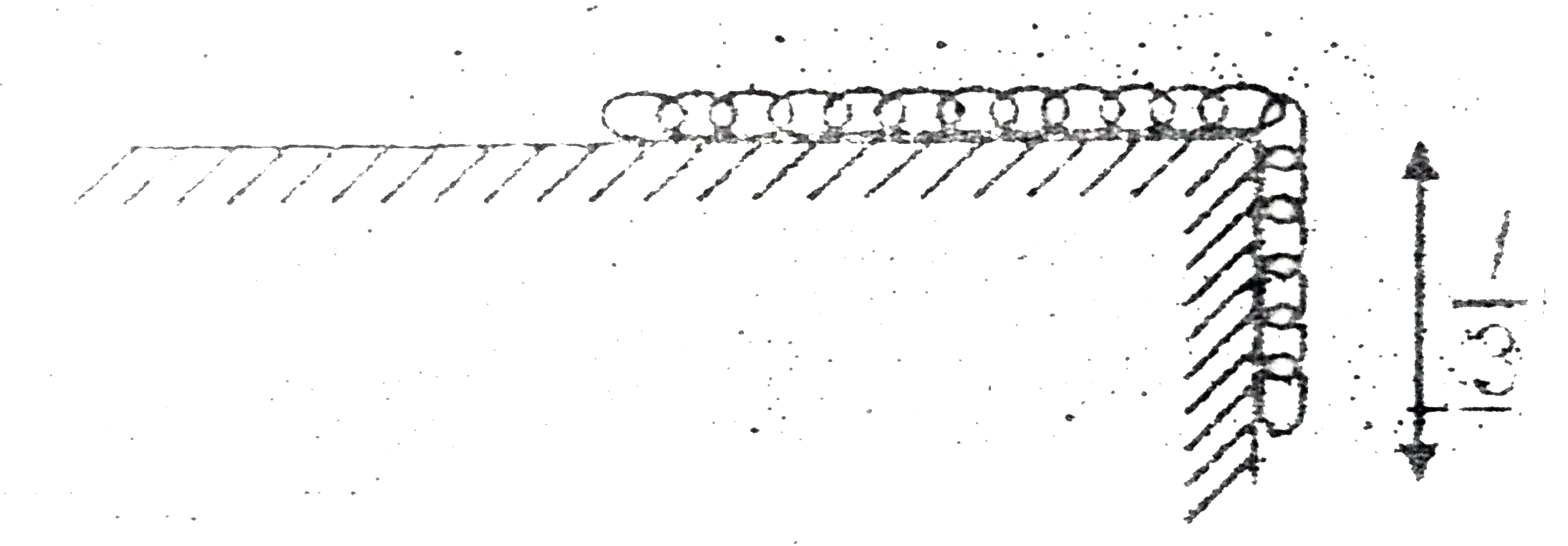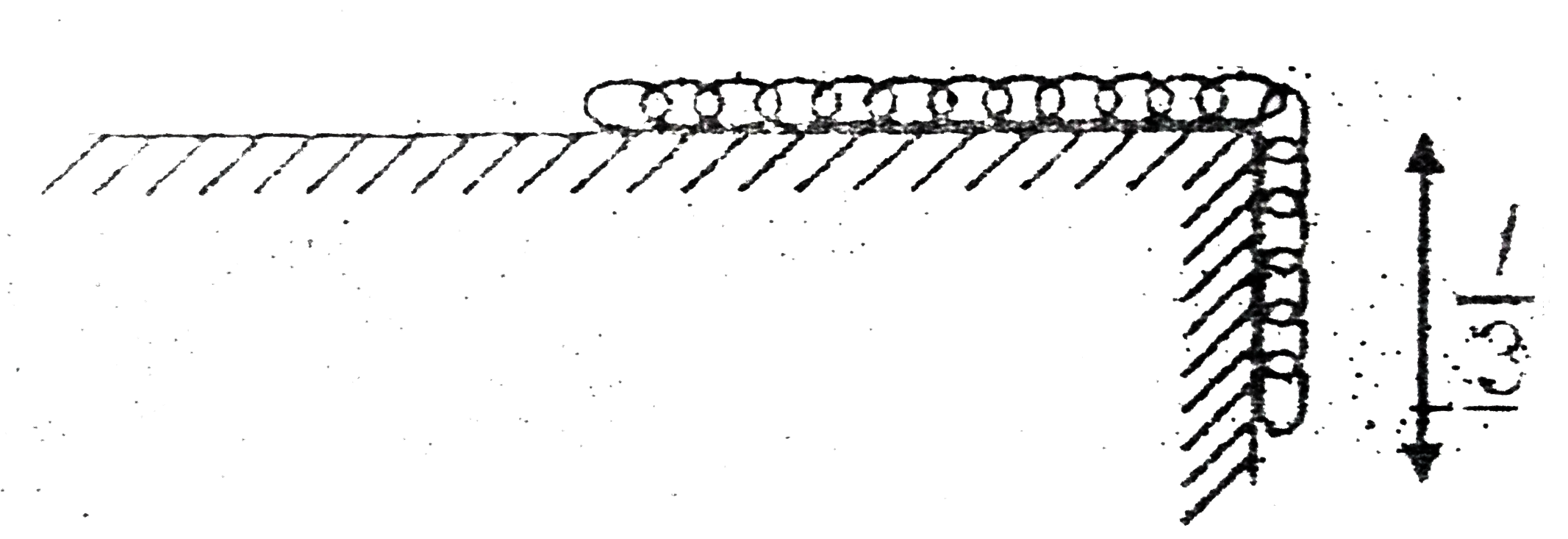A chain of mass m and length l lies on a horizontal table. The chain is allowed to slide down gently from the side of the table. Find the speed of the chain at the instant when last link of the chain slides from the table. Neglect friction everywhere.
(a) the force from thelicopter and
(b) the gravitational force on her
(c ) What are speed ot the kinetic energy and.
(d) the speed of the astronaut just before she reaches the helicopter?
To find the speed of the chain at the instant when the last link of the chain slides from the table, we can use the principle of conservation of energy. Here are the steps to solve the problem:
Step 1: Understand the situation
The chain of mass m and length l is initially lying on a horizontal table. As the chain slides off the table, it descends under the influence of gravity.
Step 2: Identify the change in gravitational potential energy
When the chain is fully on the table, the center of mass of the chain is at a height of 0. As the last link of the chain slides off the table, the center of mass of the chain descends by l2 (since the center of mass of a uniform chain is at its midpoint).
Step 3: Calculate the change in potential energy
The change in gravitational potential energy (ΔPE) of the chain when it descends is given by:
ΔPE=mgh
where h=l2 is the height descended by the center of mass. Thus,
ΔPE=mg(l2)=mgl2
Step 4: Set up the kinetic energy equation
At the moment when the last link of the chain leaves the table, all the potential energy lost will be converted into kinetic energy (KE). The kinetic energy of the chain can be expressed as:
KE=12mv2
Step 5: Apply conservation of energy
According to the conservation of energy:
ΔPE=KE
Substituting the expressions we derived:
mgl2=12mv2
Step 6: Simplify and solve for v
We can cancel m from both sides (assuming m≠0):
gl2=12v2
Multiplying both sides by 2 gives:
gl=v2
Taking the square root of both sides, we find:
v=√gl
Final Answer
The speed of the chain at the instant when the last link slides from the table is:
v=√gl
---
The chain of mass m and length l is initially lying on a horizontal table. As the chain slides off the table, it descends under the influence of gravity.
When the chain is fully on the table, the center of mass of the chain is at a height of 0. As the last link of the chain slides off the table, the center of mass of the chain descends by l2 (since the center of mass of a uniform chain is at its midpoint).
The change in gravitational potential energy (ΔPE) of the chain when it descends is given by:
ΔPE=mgh
where h=l2 is the height descended by the center of mass. Thus,
ΔPE=mg(l2)=mgl2
At the moment when the last link of the chain leaves the table, all the potential energy lost will be converted into kinetic energy (KE). The kinetic energy of the chain can be expressed as:
KE=12mv2
According to the conservation of energy:
ΔPE=KE
Substituting the expressions we derived:
mgl2=12mv2
We can cancel m from both sides (assuming m≠0):
gl2=12v2
Multiplying both sides by 2 gives:
gl=v2
Taking the square root of both sides, we find:
v=√gl
The speed of the chain at the instant when the last link slides from the table is:
v=√gl
Similar Questions
A uniform chain of mass m and length l is lying on a horizontal table with one-third of its length hanging over the edge of the table.

What is the speed of the chain, when it just loses contact with the table?
View SolutionA uniform chain of length L lies on a smooth horizontal table with its length perpendicular to the edge of the table and a small portion of the chain is hanging over the edge. The chain starts sliding due to the weight of the hanging part
View Solution
Knowledge Check
A uniform chain of length 2m is kept on a table such that a length of 60cm hangs freely from the edge of the table . The total mass of the chain is 4kg What is the work done in pulling the entire the chain the on the table ?
A12.9JB6.3 JC3.6 JD2.0 J
A uniform chain of mass m and length l is lying on a horizontal table with one-third of its length hanging over the edge of the table.

If the chain is limiting equlibrium, what is the coefficient of friction for the contact between table and chain?
View SolutionA uniform chain of length 4m is kept on a table such that a length of 120 cm hangs freely from the edge of the table. The total mass of the chain is 4 kg What is the work done in pulling the entire chain on the table ?
View SolutionA chain AB of length l is located on a smooth horizontal table so that its fraction of length h hangs freely with end B on the table. At a certain moment, the end A of the chain is set free. With what velocity with this end of the chain slip off the table?

View SolutionA uniform chain of mass 4 kg and length 2 m overhangs a smooth table with its one third part lying on the table Find the speed of chain as it completely slips of the table. (Take g=10ms2)
View SolutionA uniform chain of mass m & length L is kept on a smooth horizontal table such that Lnportion of the chaing hangs from the table. The work dione required to slowly bringsthe chain completely on the table is
View SolutionA man places a chain (of mass m and length l) on a table slowly. Initially, the lower end of the chain just touches the table. The main brings down the chain by length l/2. Work done by the man in this process is
View SolutionA uniform chain of mass 4 kg and length 2 m is kept on table such that 3/10th of the chain hanges freely from the edge of the table. How much work has to be done in pulling the entire chain on the table?
View Solution
